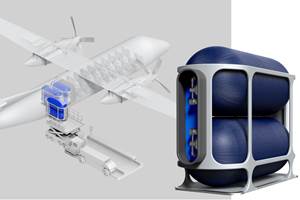Beyond Gravity to supply ULA with composite payload fairings, adds to Amazon satellite contract
Beyond Gravity will deliver 38 carbon fiber payload fairings, in addition to Amazon CFRP dispenser contract, for Project Kuiper, expands U.S. production facility capacity.
Rendering of the first ULA Vulcan launch with Amazon Kuiper satellites. Photo Credit: Amazon, Beyond Gravity
In mid-March this year, Beyond Gravity (formerly RUAG Space, Zürich, Switzerland) was awarded a contract to develop and deliver the carbon fiber-reinforced polymer (CFRP) dispenser system for Amazon’s planned satellite constellation. Now, United Launch Alliance (ULA, Centennial, Colo., U.S.) has also awarded Beyond Gravity the contract to supply 38 carbon fiber payload fairings for its Vulcan rockets (more about the payload fairings below), which are being used to deploy the Amazon satellites.
Project Kuiper aims to provide affordable, high-speed broadband connections around the world via a 3,236-satellite constellation placed into low Earth orbit (LEO).
“I am proud that the Vulcan launch vehicles that will carry the Kuiper constellation into space rely on our leading-edge and proven technology in the field of composite structures,” André Wall, CEO of Beyond Gravity, says. “This contract with ULA marks the next chapter in our long-standing partnership and further strengthens and expands our presence in the U.S.”
The 38 shipsets Beyond Gravity is providing to ULA comprise three composite structures, which include a carbon fiber payload fairing (the top of the launch vehicle protecting the satellites on their way into orbit), the heat shield that protects the launch vehicle from the heat generated by the engine during launch and an interstage adapter that interfaces to the launcher’s upper stage. To handle this volume, Beyond Gravity is doubling its production capacity in the U.S. and is working with ULA to build a new manufacturing facility at its site in Decatur, Ala., U.S., by early 2024, creating 200 additional jobs; this is in addition to new ground for a new production facility in Linköping, Sweden (see “RUAG rebrands as Beyond Gravity, boosts CFRP satellite dispenser capacity”).
The new building measures more than 250,000 square feet of space, including 30,000 square feet of warehouse along with 20,000 square feet for offices. “With this new facility, Beyond Gravity will move to the next level: From producing a total of 10 payload fairings in Decatur per year to a target of 25,” Paul Horstink, who heads the Launchers Division as executive vice president, states: “Also, Beyond Gravity’s workforce in the U.S. will grow from just over 200 today to an expected 400 employees.”
Since 2015, ULA and Beyond Gravity have had a strategic partnership for the production of composite structures for the Atlas V rocket as well as the Vulcan Centaur launch vehicle (see “ULA, RUAG Space extend and expands Atlas and Vulcan Centaur rocket programs cooperation”).
Beyond Gravity also has a strong history in providing composite components, structures and expertise for other space applications, including the most recent OneWeb satellite launch, the NASA Artemis missions and the flight of the Vega-C rocket.
Related Content
The state of recycled carbon fiber
As the need for carbon fiber rises, can recycling fill the gap?
Read MoreMaterials & Processes: Fibers for composites
The structural properties of composite materials are derived primarily from the fiber reinforcement. Fiber types, their manufacture, their uses and the end-market applications in which they find most use are described.
Read MoreInfinite Composites: Type V tanks for space, hydrogen, automotive and more
After a decade of proving its linerless, weight-saving composite tanks with NASA and more than 30 aerospace companies, this CryoSphere pioneer is scaling for growth in commercial space and sustainable transportation on Earth.
Read MoreCarbon fiber in pressure vessels for hydrogen
The emerging H2 economy drives tank development for aircraft, ships and gas transport.
Read MoreRead Next
Composites end markets: Energy (2024)
Composites are used widely in oil/gas, wind and other renewable energy applications. Despite market challenges, growth potential and innovation for composites continue.
Read MoreFrom the CW Archives: The tale of the thermoplastic cryotank
In 2006, guest columnist Bob Hartunian related the story of his efforts two decades prior, while at McDonnell Douglas, to develop a thermoplastic composite crytank for hydrogen storage. He learned a lot of lessons.
Read MoreCW’s 2024 Top Shops survey offers new approach to benchmarking
Respondents that complete the survey by April 30, 2024, have the chance to be recognized as an honoree.
Read More


























